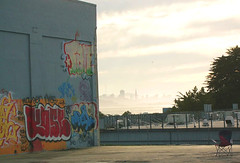 Having explored these boxy boneyards in person, I've long been inspired to re-use them in the creation of space. No building is free of materials carried in these standards; formalizing the relationship by appropriating the container as containment method is a lovely reminder for future users.
Having explored these boxy boneyards in person, I've long been inspired to re-use them in the creation of space. No building is free of materials carried in these standards; formalizing the relationship by appropriating the container as containment method is a lovely reminder for future users. Graft Architects has crafted the Platoon Kunshthalle arts facility in Korea out of 28 standard shipping containers. In order to utilize the wall-as-structure nature of the containers, they surrounded a central open space with smaller programs (artist live-work, offices, washrooms, etc.)
Graft Architects has crafted the Platoon Kunshthalle arts facility in Korea out of 28 standard shipping containers. In order to utilize the wall-as-structure nature of the containers, they surrounded a central open space with smaller programs (artist live-work, offices, washrooms, etc.)  which could make use of the container as-is. In doing so they allowed for a sweeping architectural gesture at the heart of the space, at the same time playing with the double-blinding action of fitting any- and everything under the sun into the same blank box.
which could make use of the container as-is. In doing so they allowed for a sweeping architectural gesture at the heart of the space, at the same time playing with the double-blinding action of fitting any- and everything under the sun into the same blank box. Closer to home, DeMaria Design used the basic geometry and structure of the shipping container, but dematerialized it by replacing steel monocoque with glass curtain wall and stucco in places, inverting the relationship of cargo and crate. The resulting Redondo Beach House has an inviting modernist open plan in which the footprint of the shipping industry is still viscerally present.
Closer to home, DeMaria Design used the basic geometry and structure of the shipping container, but dematerialized it by replacing steel monocoque with glass curtain wall and stucco in places, inverting the relationship of cargo and crate. The resulting Redondo Beach House has an inviting modernist open plan in which the footprint of the shipping industry is still viscerally present.Found objects have inspired art since the beginning of time. That this paradigm has continued in contemporary architecture is no surprise --- green meets steel in containerized reconstruction.

2 comments:
Nice article. Where, though, could an interested reader find a website for purchasing their own raw used container for their own experiments? :)
In the east bay, the source I've used is Allied Storage Containers on 54th Ave. They deliver half or whole containers to you locally.
Post a Comment